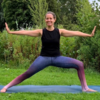Ashtanga yoga is in the Netherlands mostly known as a physically intensive vinyasa yoga form that is practiced in a fixed series. Traditionally, the series is taught your posture by posture as soon as you are ready for the next step. Although the approach of this yoga form is also spiritual, be ready to sweat. In Ashtanga yoga you work with yoga postures, breathing and drishti (the point you are looking at).
Ashtanga Mysore
Traditionally, ashtanga yoga is taught in Mysore style. You will not learn the whole ashtanga yoga series at once, but (if the yoga teacher thinks you are ready for that) one posture at the time will be added to your series until you ultimately you will practice the complete ashtanga series. Hereby your practice of the previous postures will prepare you to become ready for the other yoga postures, to slowly open up. An advantage of this is then do not start too quickly with a certain yoga posture. To understand this, it is useful to remember that yoga postures are always meant to be therapeutic and not because they look cool.
"Do your practice and all is coming." ~ K. Pattabhi Jois
Ashtanga Led
In yoga schools that offer ashtanga yoga classes, one will often also see led lessons offered. Here you are guided through the series by the yoga teacher through instructions. Often there are different variants of the led classes, in which a quarter, half or the whole series is practiced. Sometimes indicated as beginners and advanced classes, so you can choose a lesson that fits your current yoga practice.
A Taste Primary Series of Ashtanga Yoga by: Bibi Lorenzetti from kodezero on Vimeo.
The eightfold path
Ashtanga yoga also stands for the eightfold path of Patanjali, as described in the Yoga Sutra consisting of Yama, Niyama, Asana, Pranayama, Pratyahara, Dharana, Dhyana and Samadhi.
Six Ashtanga yoga series
In total there are six ashtanga yoga series, but there are only a few yogis worldwide who practice all 6 ashtanga yoga series. Most practice the primary, some the secondary series and then there are fewer and fewer people who practice subsequent series. The great thing about this is that even though the first (two) series offer sufficient challenge for most people, we can always keep on learning. If you are ready for a next step, there is a method for that. However, don't be in a hurry. Here too, the quality of your yoga practice is much more important to be able to continue practicing yoga (without unnecessary injuries) than the quantity of the postures themselves.
"Yoga is 99% practice and 1% theory."~ K. Pattabhi Jois
Inspiring ashtanga yoga teachers
An ashtanga yoga teacher that we think is really inspiring is Kino MacGregor. Kino has been practicing ashtanga yoga for more than 18 years and was trained by ashtanga yoga founder Sri K. Pattabhi Jois in Mysore. Her yoga school is located in Miami, but since she also created many DVDs, wrote books and founded the yoga platform Omstars, it is certainly possible to follow her lessons from the Netherlands. She is also very active on Facebook and Instagram in which she communicates about her yoga practice in a very open and humble way.
Ashtanga Yoga Clothes
Women often wear yoga legging and a yoga tank top in their ashtanga asana yoga practice. If that is too hot for you (because you are definitely going to sweat in this yoga style), you can also wear a yoga sport bra and yoga short. With our high-tech designer yoga brands like K-DEER, Noli, Teeki, LaLa Country Comfy Wear, Onzieand Dragonfly, we have great yoga outfits for all body types. Click HERE to be inspired by our wide collection of perfectly fitting designer yoga clothing.



 BRAND
BRAND
 PRODUCTS
PRODUCTS
 SALE
SALE
 BOUNDLESS ENERGY
BOUNDLESS ENERGY
 YOGA & AYURVEDA
YOGA & AYURVEDA
 YOGA BLOG
YOGA BLOG









